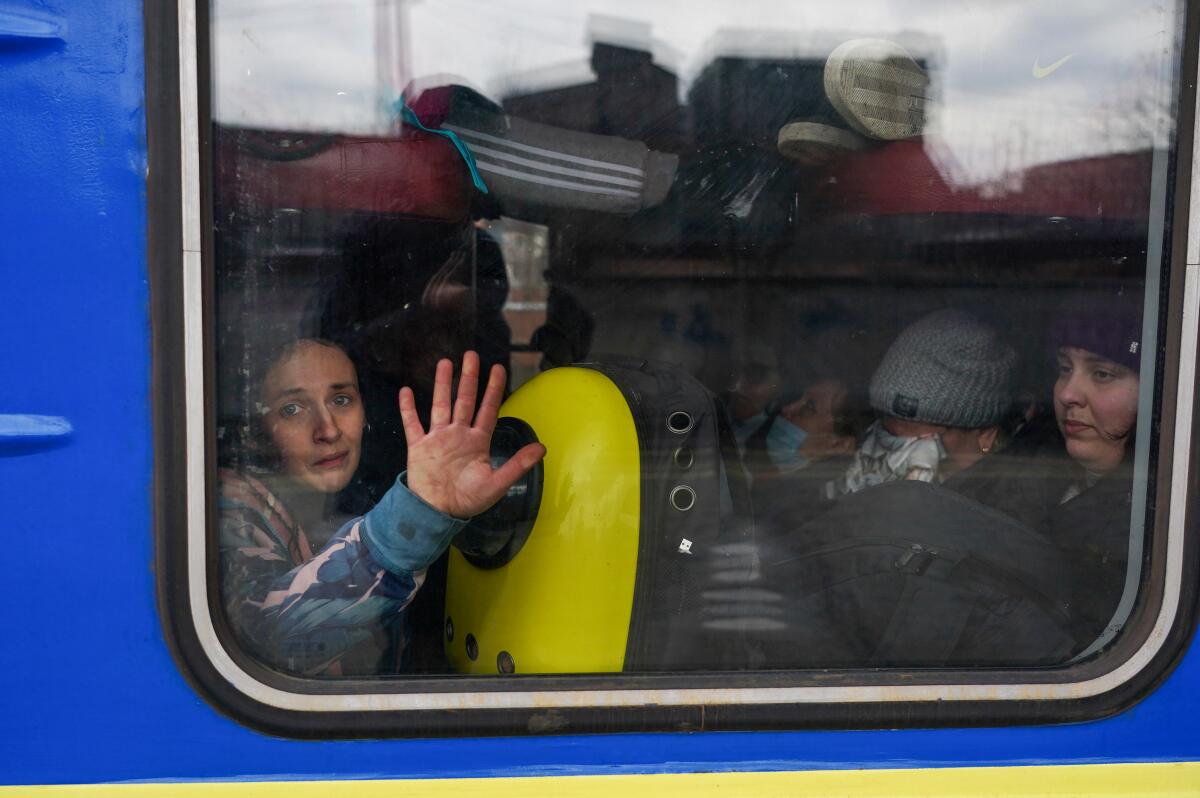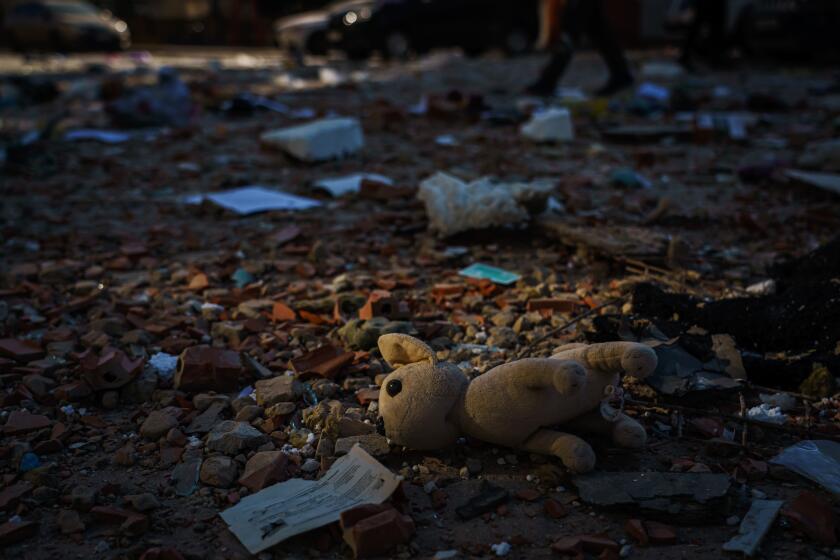As bad as the war in Ukraine is now, it’s likely to get worse

- Share via
WASHINGTON — Last week, Russian President Vladimir Putin spent 90 minutes on the phone with French President Emmanuel Macron, who asked him to declare a ceasefire in Ukraine.
Not interested, Putin replied.
“He refuses to stop his attacks,” Macron wrote on Twitter after the call.
A French official said Putin seemed determined “to take control of all of Ukraine.”
“The worst is yet to come,” the official added.
Putin’s invasion of Ukraine is in its second week. Some Russian units are mired in mud, but the offensive is escalating overall.
The State of the Union speech helped improve how voters view Biden’s empathy. Leadership ratings, however, remain a weak point in a turbulent world.
As the invasion has escalated, so, too, have economic sanctions imposed by the U.S. and its allies. And, like Ukraine’s armed forces, the sanctions have had more punch than expected. The Russian ruble has plunged in value, and ordinary Russians have scrambled to ATMs to try to get their money out of endangered banks.
But the two escalations are far from equivalent.
The sanctions have clearly damaged Russia’s economy, but there’s no sign that they have affected Putin’s calculus.
More Russian units have moved into Ukraine. Russian missile and artillery strikes on civilian neighborhoods have stepped up. Ukraine’s three biggest cities — including Kyiv, the capital — are in danger of falling.
Ukraine’s defenders are fighting courageously, but they are slowly losing ground.
“Sanctions may influence Russian decision making down the road,” said Richard N. Haass, president of the nonpartisan Council on Foreign Relations. “But they won’t stop the siege of Kyiv.”
Swaths of Ukraine have fallen into Russian hands. Corpses scattered in the snow. Rockets rain daily on civilians. The capital, Kyiv, waits in cruel limbo for advancing Russian forces.
The Russian president has waged war against cities before and has been rewarded with success.
Putin came to power in 1999 largely by waging a savage war against separatists in Russia’s mostly Muslim republic of Chechnya. The resulting campaign killed tens of thousands of civilians.
The lesson for Putin: Ruthless military action works.
“Every time you think, ‘No, he wouldn’t, would he?’ Well, yes, he would,” Fiona Hill, a former White House expert on Russia, said in an interview with Politico.
Putin’s intentions toward Ukraine should have come as no surprise. He has publicly demanded since 2007 that the country be returned to some form of Russian control. The CIA warned that he might invade Ukraine as early as 2008, Hill noted. (She was a CIA intelligence analyst at the time.)
“If he can, he is going to take the whole country,” she said.
Each day, multi-generational Ukrainian families — grandparents, their children and grandchildren — arrive at borders in Poland and other neighboring nations. Meantime, would-be fighters and aid streams into Ukraine.
Putin may not want to occupy all of Ukraine’s territory, she added, but he may want to divide it into “a fractured, shattered Ukraine.”
And he may be willing to fight for a long time. His war in Chechnya lasted almost 10 years.
The Western response is aimed at raising Putin’s costs until he — or Russia’s military brass, its oligarchs and the Russian public — decide that their losses from the war outweigh any benefits. That, too, could take a long time.
“Putin has shown no interest in a negotiated outcome that’s within the ZIP Code of reality,” Haass told me. “That could change, but only if three things occur: if his military suffers high battlefield costs, if the sanctions begin to exact a real economic cost and if popular unrest grows.
“Our policy ought to be aimed at bringing about those three conditions.”
Sanctions hawks argue that in addition to punishing Putin in the near term, the measures serve a separate long-term U.S. interest by weakening Russia economically and militarily.
Ukrainians have been forced to flee their homes or fight back as Russian forces attack their cities. These photos and maps tell the story.
“Sanctions will worsen Russia’s position in its long-run competition with western countries,” Edward Fishman, a former State Department expert now at Columbia University, told me. “We have zero interest in enhancing Russian power.”
He predicted that the sanctions would stay in place “as long as Putin is in power, if not longer,” in “a long-term war of attrition.”
But an original goal of these sanctions was to persuade Moscow to change course. To accomplish that, the United States needs to offer Russians the prospect of at least some sanctions relief if they withdraw their forces.
That kind of offer isn’t likely to change Putin’s mind, but it could help increase pressure on him from his military and his oligarchs, as well as the Russian public.
“I can imagine putting out — with the Ukrainians participating — some definition of a negotiated outcome that could produce some sanctions relief,” Haass said. “But we’re not there yet.”
President Biden, for one, isn’t there yet. His spokeswoman, Jen Psaki, said last week that sanctions relief isn’t on the table.
“We’re in the middle of an invasion, so I don’t think now is the moment where we are giving anybody that sort of an offramp,” she said.
Translation: For now, both sides are still escalating.
That French official was probably right. The worst is yet to come.
More to Read
Get the L.A. Times Politics newsletter
Deeply reported insights into legislation, politics and policy from Sacramento, Washington and beyond. In your inbox twice per week.
You may occasionally receive promotional content from the Los Angeles Times.















